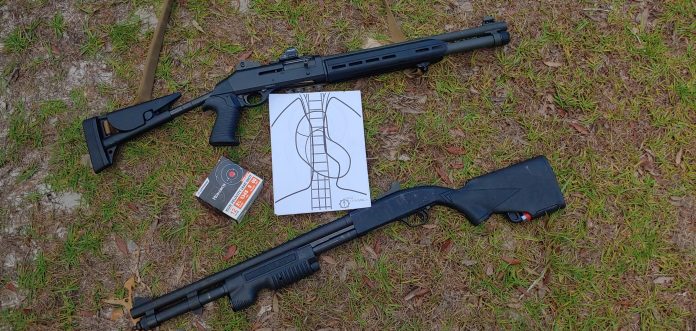From Jack Clemons
In 2004 the United States Special Operations Command (USSOCOM) solicited an upgraded modular assault rifle system through the SCAR Program (Special Operations Forces Combat Assault Rifle). The winner of the program was FN Herstal and their rifle holds the title SCAR.
The Mk16 and Mk17 were brought operational with US Forces in 2009 and are fast approaching a decade of service.
Advertisement — Continue Reading Below
FNH, capitalizing on their win with SOCOM, commercialized the SCAR with the SCAR16s and SCAR17s systems, built minus select fire and with 16″ barrels. The SCAR now serves as a service rifle in over 20 nations and has a massive popular following commercially in the US and worldwide. It’s an impressive weapon system with a well developed reputation for reliability and endurance.
However behind the scenes the wheels are always turning in PIP’s or Product Improvement Programs.
The SCAR was designed in 2004 but fielded in 2009 with five years of modern development time in between and eight years more post fielding with US Forces and commercial release.
During that time both government solicited and private aftermarket PIP’s have given us a vibrant aftermarket for the SCAR. One of the most notable was in 2010, SOCOM stopped procuring the SCAR16/Mk16 variant in favor of having a new lower receiver, bolt carrier, and barrel developed for the more favored Mk17.
Advertisement — Continue Reading Below

SOCOM (rightly so IMO) figured that the legacy 5.56mm weapon systems in inventory were mission capable and as such the Mk16 didn’t offer a capability the HK416, M4A1, Mk12, and Mk18 couldn’t cover… the Mk17 was the rifle to invest in and PIP’s should and did revolve around the SCAR17 platform to give SOCOM and the rest of the SCAR’s user base the rifles they needed.
Commercially the SCAR16 is more popular though I recently saw numbers that suggest a 4:1 favoring of the SCAR17. While anecdotal, my own experience fits that pattern with multiple close friends owning SCAR17s rifles and most who have SCAR16s rifles own both 16s & 17s. AR’s are still largely favored in 5.56.
Advertisement — Continue Reading Below
Me personally… I will own a both a 17s and a 16s shortly, but my preference is the 17. Chosen along the same logical lines that SOCOM used the SCAR17s is the one I would keep as my “One Rifle” in the ever popular hypothetical ‘if you could only have one gun’ scenario.
But let us return to the topic of PIP’s and leave a SCAR review for the future.
I covered how government PIP’s work briefly. The end users request an update, change, or addition and the requisite company roles it out for installation across the platforms per the request. Magpul’s SCAR Safety is smaller example in addition the various Mk17 modularity options seen in the poster above, all of them that are changes from the original Mk17 are the result of a PIP.
Internal PIP’s within the company can come in two forms. The first, we don’t as often notice, are subtle design changes and improvements. The shape of a selector switch or gas block. The change in material, fit, or finish on a piece or multiple pieces. Small design upgrades for the purpose of making the system more durable, reliable, easier to manufacture, and more cost effective as production and use continue. Companies do this continuously. The second and more noticeable are advertised generational improvements. The product has been revised, redesigned, and evolved enough for the company to announce the updates as an entirely new product with the previous one as legacy. The Glock Gen5 and Smith & Wesson M&P2.0 are good examples.
Advertisement — Continue Reading Below
The final type are third party commercial PIP’s and this is how we develop a thriving aftermarket. Companies see needs or perceived needs and develop products to fit. These help keep products up with emerging technologies, tactics, techniques, and procedures. Not every development is useful or widely adopted but so many variations are tried and can be tried that product improvement can and does happen very rapidly.
Grips, triggers, stocks, sights, safeties…
And Handguard Rails.
Advertisement — Continue Reading Below
Midwest Industries SCAR SOCOM Handguard

Back in May the results of a NSWC-Crane study found that of the newly developed competing mounting systems, Magpul’s M-LOK and VLTOR’s Keymod, that M-LOK exhibited better overall characteristics. While both were improvements over the legacy MIL-STD-1913 Picatinny rails M-LOK exhibited enough of an advantage that SOCOM adopted it moving forward. The US Military as a whole is following the lead of SOCOM and this can be seen in the new M110A1, the first weapon system to sport M-LOK over Picatinny as standard.
Fun Fact: Midwest Industries handguards were a part of the USSOCOM test, along with Aero Precision and Seekins.
Advertisement — Continue Reading Below
With M-LOK chosen as SOCOM’s Gold Standard companies went full bore into production. Even BCM who had long been a KeyMod supporter just released the MCMR.
Midwest Industries, having had their M-LOK emerge victorious from the fires, has since gone gangbusters developing and fitting a myriad of firearms. AR’s, HK’s (MP5 review here), IWI’s Galil ACE and Tavor, CZ Scorpion…
And the FN SCARs
Midwest Industries has 16 handguards available for the SCAR. They are not new to upgrading the platform with their standard Picatinny, SSR, and standard KeyMod and M-LOK extensions.
Advertisement — Continue Reading Below

The SOCOM series (4 in total) are the latest in the lineup and differ by lowering the profile of the forward 12 o’clock rail closer to the barrel instead of paralleling the top receiver rail, this allows a DBAL or equivalent laser aiming solution reduced offset from the barrel. This shorter SOCOM rail also lightens the design by 3.5 oz over the legacy.
The SOCOM adds 4.75 inches of space with a 4 slot picatinny rail at 12 o’clock forward of the front sight. 2 M-LOK slots each at 3, 6, and 9 o’clock forward of the gas block. 3 M-LOK slots replace the 6 o’clock under barrel rail. 2 single M-LOK slots go on in place of the stock polymer picatinny rails at 3 and 9 o’clock and one has a machined QD swivel mount, end user placed left or right. Perfect to keep my 2-Point Vicker’s Blue Force Gear Sling on the rifle and with less necessary additional hardware. The portion directly beneath the 12 o’clock picatinny rail is machined into a straight tube allowing removal of the piston for cleaning and servicing without removal of the handguard. Along the entire length, approximately every half M-LOK slot, Midwest Industries added small oblong machine cuts that increase the available griping surface area.
One M-LOK picatinny rail section comes with the SOCOM Handguard allowing immediate attachment of at least one of your picatinny accessories. My BCM Mod 3 short vertical grip in my case.
Advertisement — Continue Reading Below

Adding the SOCOM to the SCAR17s has several immediate effects. Griping the rifle becomes much more comfortable, especially for AR platform shooters accustomed to more handguard real estate. The rifles forward profile is more svelte and streamlined with the absence of rails. A c-clamp grip becomes much easier. The continuous lower portion extending around the gas block allows for grips forward of the receiver not possible otherwise.
While I don’t shoot with my support arm fully extended my most comfortable support hand position would put my index and middle fingers firmly grabbing the gas block, less than optimal…
Bringing my hand further back onto the receiver wasn’t an unworkable solution however anything mounted on either picatinny rail had the potential to interfere. The MI SOCOM simplifies that and doesn’t force me to compete for real estate or compromise where I want to place mission essential equipment for best control access.
The SCAR is light but front heavy in its layout and initially the MI SOCOM compounded that. Live fire though the control advantage of having my hands ideally placed mitigated the weight shift completely.
In the categories of increased ergonomics, improved modular capability, and aesthetics the MI SOCOM for the SCAR gets my full recommendation.
Installation
On Midwest Industries Webpage and on the directions that come with the handguard is a very important line
-Gunsmith Installation Recommended
Why?
Tools
You need a torque wrench with a T25 bit and able to be set at 62 in/lbs. Ideally one adjustable from 35 in/lbs to 62 in/lbs or more by single lb increments. There are several SCAR specific torque wrenches available on the market but a gunsmith or armorer is likely to have them if you do not feel like making the purchase.
In addition to the torque wrench and bit, a heat gun is useful. Failing that a high BTU blow dryer will work. The screws holding the bottom rail onto the rifle are threadlocked and heat will help loosen them.
A proper hex wrench/allen wrench is needed to remove the side rails also.
You will be removing the SCAR’s barrel. This is why the 62 in/lb is essential. Remounting the barrel requires proper torque.
Midwest Industries provides a full installation video
As an armorer myself I took the opportunity to justify buying more tools.
The install is not a hard process but you must use the correct tools and follow the directions. Failure to do so will result in an unsafe gun, broken parts, or both.
Conclusion
I stated it above. The MI SOCOM Handguard took my primary rifle and made significant improvements to ergonomics and accessory management. I highly recommend the upgrade.















